Humanity creates virtual reality. Like any product of human activity, it affects a person and society as a whole. Moreover, virtual reality is far-out media and leaves its mark in a special way. Many immersive virtual experiences confirm that people react to them more emotionally than to traditional media. Let’s figure out how empathy and virtual reality are interrelated and what is their potential in social conflicts’ resolution.
What is empathy?
Empathy is a possibility to realize what other person feels as the result of his experience. Very often this notion is understood as the ability to empathize with a human or to put oneself in his or her place. The range of manifestation of empathy varies widely, from a mild emotional response to a complete immersion in the world of feelings of another person.
To better understand what empathy is, let’s turn to science. According to Theresa Wiseman, professor of applied health research in cancer care (Southampton, UK), who practically explores the effect of empathy, 4 attributes of empathy exist. The first one is the ability to see the world like another person sees. The second component is a skill to understand a stranger’s feelings. The third feature lies in accepting people along with their imperfections, not condemning at the same time. Lastly, the fourth attribute is communicating in such a way as to let people know that one understands their feelings.
What is the use of empathy?
Why to develop empathy? Like any other phenomenon, empathy has its dark side, in particular, difficulty in controlling emotions, mood swings, feeling of loneliness or stronger experience of someone else’s pain than his or her own. Nevertheless, the advantages of empathy are numerous, whilst minuses are only the consequences of a deeper ability to feel. Let’s investigate what empathy can give you.
Facilitates social interaction
Empathy allows you to understand the emotional states of others more deeply. In turn, it helps to establish closer social contacts with many different people.
Provides more pleasure
A sympathetic person sees all the complexity of people and situations. More comprehensive perception of the world enhances satisfaction from life. Сonsequently, an empath (a person with a developed sense of empathy) is more inclined not to get bored and to live a full life. 
Helps to distinguish truth from lies
An empath easily distinguishes true and false. Even if everything looks as veridical as possible, such person is very hard to deceive, as he or she feels a trick on the emotional level.
Enriches thought process
As a general rule, developed empathy is a sign of high emotional intelligence and great creativity. Daniel Goleman, an American writer, psychologist, author of more than 10 books on psychology, education, and leadership, believes that emotions closely interact with the intellect. They fundamentally influence the process of logical thinking. In addition, emotions enrich the thought process, helping to choose alternative solutions.
Creates more positive attitude towards people and situations
A person with developed empathy is very difficult to offend. He or she accurately feel the motives of people, their intentions, and purposes. Such a person gives people around the right to make mistakes and forgive easier. A person with a developed capacity for empathy can perceive insults and taunts not as a negative message in his or her address but as intrapersonal abuser’s problems. Primarily, such a behavior causes pity and compassion.
Increases the chances of becoming a leader
Richard Boyatzis and Annie Mackie in their book “Resonant Leadership: Renewing Yourself and Connecting with Others Through Mindfulness, Hope, and Compassion” devoted an entire chapter to empathy as one of the key factors of leadership. 
Empaths are more suitable for leadership positions. Due to the fact that they see much more than other people, empaths manage to build effective teams and to remain flexible in any circumstances. Leaders with developed empathy embody their qualities in an individual approach to each employee. Such managers are more positively perceived both by top-management, and subordinates.
Deepens introspection
And finally, empathetic people are capable of better understanding what is happening in their souls. Thanks to this, they feel happier than those who are deprived of this ability. It is also worth noting that empathy is more characteristic of sensitive people. They, as a rule, have a labile psyche. So, like any phenomenon, empathy can sometimes have reverse side aspects, such as a sense of loneliness, mood swings or complexity of emotion control. Nevertheless, the advantages that accompany empathy decidedly outweigh its effects. 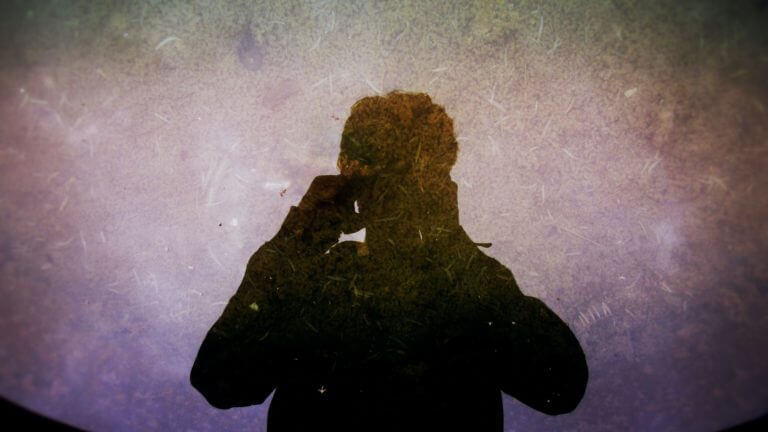
How empathy affects the solution of social problems?
There are 3 main concepts according to which people help others. The first one is called social exchange theory. According to it, a person decides on assistance or inaction by comparing the costs and benefits. If benefits exceed costs, a person will be more inclined to help. The following two concepts differ significantly from the previous one. C. Daniel Batson, an American social psychologist, put forward an empathy-altruism hypothesis, which assumes that empathy induces a desire to help without expecting any benefits. One more theory, called “empathy-joy”, implies that the primary reason why one helps somebody is the feeling of joy as a result of altruistic behavior.
Let’s assume that developed empathy affects not only the person himself but also his social connections. Consequently, the more empaths exist, the more the society and the world around us can change.

One more thing that fundamentally changes the world, and is expected to keep doing it in the long term period, is virtual reality.
How VR transforms the world?
Virtual reality gave us the possibility to such experiences which you could only dream of earlier. First of all, virtual reality allows feeling the “presence effect”. One of the present concepts, proposed by Lombard and Ditton, implies that “presence” is a sense of realism, such as computer-generated environments looking, feeling, or otherwise seeming real. In this way, VR correlates with this understanding as nothing else. Besides, technology has reached such a level of development that immersion in another reality is possible almost from anywhere without travelling long distances. In addition, thanks to haptic feedback and motion capture, virtual reality is changing the process of learning. These technologies give the opportunity to immerse ourselves in any activity faster without many risks and do it more interactively than ever before. Among other things, immersive virtual environments (IVEs) give a chance to test unique emotional experience.
“We are entering an era that is unprecedented in human history, where you can transform the self and experience anything the animator can fathom… We can use VR to change your attitudes about yourself or reduce racial bias. I like to say, we should think of VR not as a media experience but closer to an actual experience”.
Jeremy Bailenson, director of Stanford University’s Virtual Human Interaction Lab
Human and VR: how they sculpt each other?
VR is a product made by a human. But to what extent will it change its creator?
Influence on our brain
One of the researches dedicated to VR and empathy topic was performed by StoryUp VR in collaboration with Innovation Center and the Neuromeditation Institute (Columbia, MO, USA) and Dr. Jeff Tarrant in 2017. It shows how virtual reality affects our brain. The hero of the experiment was a 68-year woman. She was immersed into the story about a group of people in Zambia who couldn’t walk. According to the World Health Organization, approximately 66.5 million people all over the world lack access to wheelchairs. The film “Gift of Mobility” shows how people who could not walk for a long time finally got the opportunity to move around easily by dint of hand carts. Throughout the experiment, the brain’s activity was recorded via EEG. Increased cognitive processing was observed. To understand complex changes in deeper structures of the brain sLORETA analyses (standardized low-resolution brain electromagnetic tomography) were used. 
This immersive virtual environment activated the parts of brain that are responsible for internal “talk”, emotional processing and empathy. Also, parahippocampal gyrus began to work actively. It allows one to encode information and find it in his or her memory. Such fact may indicate that the woman was looking for information about similar experience in her own life.
Thus, it turned out that VR story about people from the other end of the earth can evoke not only individual feeling of compassion and empathy, but also active brain regions responsible for the processing of these sophisticated emotional states.
From emotions to behavior
Many case studies of how the virtual reality affects emotions and, as a result, makes our behavior empathetic and socially responsible, were also conducted in Stanford as far back as 2006. One of the most famous of those was carried in 2011. It is about the difference in attitude to the environment depending on the existence of VR experience. Participants of the experiment were divided into 2 groups. People from the first group just read about the tree which had been cut down. The members of the second group had to do it personally in the virtual world. 
After that, all the participants declared that they felt responsible for the state of the environment. However, this was not the end of the experiment. One of the organizers, Sun Joo Ahn, pretended that she accidentally dropped a glass of water. In the issue, the members of VR experience used 20 % less paper to mop up the water.
“We showed that just three minutes of an embodied experience could produce a behavioral result.”
Sun Joo Ahn, Ph.D., assistant professor at Grady College of Journalism and Mass Communication, University of Georgia
Immersive virtual environment (IVE) as a tool for conflict resolution
Israeli-Palestinian conflict has a long history and is сharacterized by deep-rooted hatred between both sides. It is illustrated in VR documentary “My Mother’s Wing” by Here Be Dragons (formerly known as Vrse.works) in partnership with United Nations.

Children play in a bombed building in Gaza in “My Mother’s Wing”. Image credit: Here Be Dragons
Since immersive virtual environment can really change our behavior, it has enormous potential in conflict resolution. One of the researches that cover this aspect of empathy was conducted in Israel, Sammy Ofer School of Communications Interdisciplinary Center (IDC). In the course of the experiment the interactions between 60 Jewish Israeli participants and Jamil, a Palestinian, were analyzed. Jamil was a character in the VR simulation. The participants communicated through VR devices about issues relating to the Israeli-Palestinian conflict. Wherein, Jamil mirrored the language and body movements of the other side’s participants with the help of software.
The results of the experiment are amazing. Those Israeli participants, whose movements were imitated by Jamil, began to perceive communication more positively and feel compassion not to the avatar but to Palestinians as a whole. Which is even more important, the Israelis experienced an empathy increase for Palestinians regardless of feelings for them before the experiment. Even those who initially had no affirmative feelings showed the emergence of empathy for the Palestinians.
VR generates empathy or just leads it out?
Barry Pousman, co-producer of the United Nations VR documentary “Clouds Over Sidra”, believes that all artistic mediums, such as theater, writing, the movie can invoke empathy. Simultaneously, VR, in his opinion, functions, unlike aforementioned traditional mediums. According to him, VR represents quite different form of experience due to its “isolating” properties. These properties along with watching and listening to a piece of someone else’s life create empathy.
Nevertheless, there is a certain skepticism with respect to the fact that VR can generate empathy or make it properly.
Ethan Shaftel, creator of virtual arcade “Extravaganza”, believes that VR significantly loses to some other media in causing empathy. “Creating the powerful empathy that cinema routinely achieves — from movies to reality shows, to Super Bowl commercials — is something that current VR technique does not do well”, — he said. 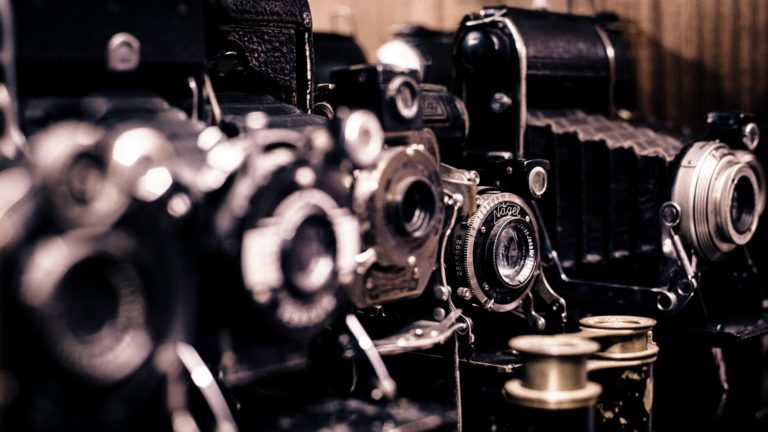
David M. Ewalt, author of prospective book “Defying Reality: The Inside Story of the Virtual Reality Revolution”, is skeptical of VR’s potential with regard to generating empathy. “If you are an empathetic person and want the world to be a better place and can watch a VR film like Sidra, it’ll bring out empathy within you that already exists. But if you’re not empathetic, not even the most convincing video will work for you. VR magnifies what’s already within the audience”, — Ewalt сonsiders.
Game developer, Robert Yang, follows the same point of view. In his blog, he wrote: “If you won’t believe someone’s pain unless they wrap an expensive 360 video around you, then perhaps you don’t actually care about their pain.”
Paul Bloom, Professor of Psychology at Yale University, the author of the book “Against Empathy: The Case for Rational Compassion”, also adds a fly into the ointment. His arguments are brought to several points. First of them is that VR is attractive. That’s why many people seek to experience it. The second reason for сriticising VR lies in the doubtful morality. He says that people in respect of whom we can experience empathy are strictly determined by our personal experience, and this can be used by VR filmmakers to make one donate. The third point is that VR can’t be immersive enough to make one feel as homeless, or disabled. “The awfulness of the refugee experience isn’t about the sights and sounds of a refugee camp; it has more to do with the fear and anxiety of having to escape your country and relocate yourself in a strange land. You can’t tap into that feeling by putting a helmet on your head”, — Paul says. “In addition, IVE is safe, that’s why it transforms into a game, like military strategy or quest. Furthermore, VR experience lasts for minutes, while victims of terrorist attacks live with psychological traumas all the time”. 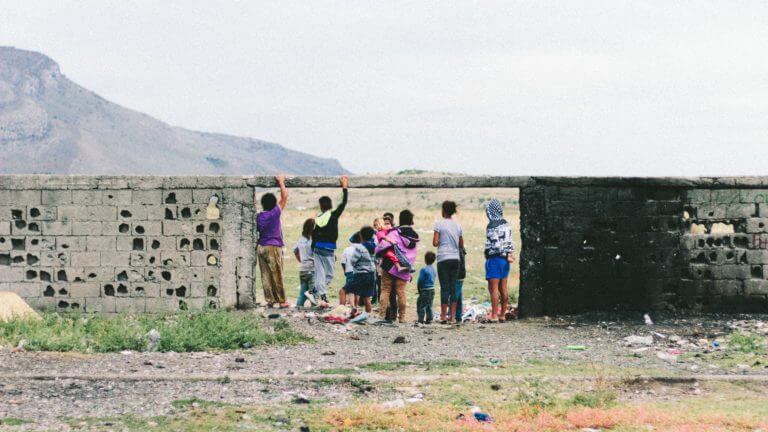
As for researches on this subject, Stanford experts’ conclusion is the following.
To evoke empathy, an immersive virtual environment should be tuned appropriately.
Tobin Asher, Stanford lab manager, declares: “The experience and context matters. The reason we do so many iterations of a lot of these pieces is because subtle things can make a difference.” Apparently, such organizations, as the International Red Cross and United Nations, learned to take into account delicacies. For instance, U.N. first VR documentary, describing a girl from Syria, “Clouds Over Sidra” let UNICEF to raise $3.8 billion, which is twice as much as planned.
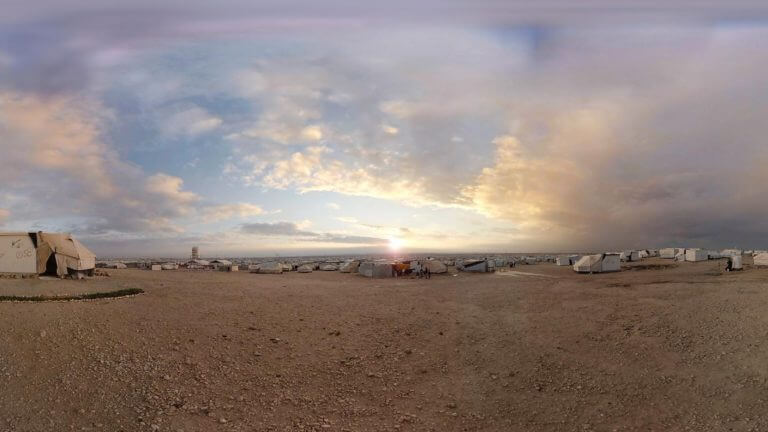
Fragment from “Clouds Over Sidra”. Image credit: Here Be Dragons
Does VR generate empathy or just allow it to go outside and incarnate in prosocial behavior? This question has to be answered in the future. However that may be, TESLASUIT team is convinced that VR is a tool, still extraordinary, but powerful. For now, virtual reality uses more or less freely only 2 out of 5 basic senses, sight, and hearing. Taste, smell, and touch are also imitated, but much more rarely. Some experts consider haptic feedback to be an integral technology to ensure full immersion. 
Besides, freedom of movement in VR is still restricted. Development of motion capture will let gradually push these limits. It is likely that complete immersion in virtual reality will allow deeper studies of interconnections between empathy and virtual reality. Let’s move on to the projects that illustrate in more detail what problems VR can solve by virtue of empathy.
When VR and emotions meet
One of the first attempts to combine emotional experience and VR was made by Jacquelyn Ford Morie and researcher, Mike Goslin in 1992. Jacquelyn is a scientist, artist, and educator acting in the sphere of immersive worlds. Artists’ article “Virtopia: emotional experiences in virtual environments” describes how creators constructed various environments which gave a different experience to every visitor. The aim of the project was to leave a deep impression with a lasting effect. The authors emphasized in their work that the more emotions a person experiences during immersion into virtual reality, the more real he or she considers the given experience: “When a person is emotionally involved in an experience, he or she is more likely to focus on immediate sensations and less likely to perceive what is happening via the analytical thought processes. The more emotionally involved a participant is, the more he or she will “buy into” the virtual world, thinking of it less as a construct and more as a personal experience”.
Thus, the more emotions are generated by virtual reality, the more a person is inclined to believe in it, as if it was really true.
Modern projects that couple empathy and virtual reality
“The machine to be another “ (TMBA) and “Library of Ourselves” The embodiment virtual system is developed in 2014 by BeAnotherLab, interdisciplinary multinational group, concentrating on studying the connection between empathy and personality using embodied experience. The сurrently developed project of the initiative group is “Library of Ourselves”. In 2017 it has been awarded an honorable mention by Starts Prize, promoting innovative projects at the conjunction of technology, science, and art.
Problem
Indifference to others is increasingly common in society. Some people do not help each other precisely because they do not understand what it’s like to be in the place of another. Nationalism, ageism, religious discrimination, sexism, racial bias and other prejudices are outcomes of insufficiently developed empathy or its absence.
Solution
As mentioned in the first part of the article, empathy and virtual reality can be an effective tool in inculcating and developing altruism. Since the roots of empathy are in the understanding of others, BeAnotherLab team decided to create an open platform “The machine to be another” for сo-creation of immersive experiences of others’ world.
Method
“The machine to be another” allows a person to see himself or herself in the body of another man and hear a stranger’s thoughts with the help of immersive goggles or a head-mounted display. Also a camera is used for tracking movement while the storyteller utilizes a microphone, and spectator listens to the speech through headphones. Meanwhile, haptic devices provide the tactile sensation. Despite that “The machine to be another” is an embodied narrative system, it also lets carrying out experiments on gender swap, body extension, pain tolerance and so on. As for “Library of Ourselves”, it is not just an ordinary VR tool, but a fully-fledged content platform which can be used as both experimental research base and an area for interactions, and сreating audiences.
Project Empathy
The conception by Benefit Studio, USA, is aimed at eliminating the difference in people’s perceptions and situations in order to reduce societal prejudices. In particular, the company focused on series of VR experiences narrating about people most impacted by the prison system, vulnerable to cultural biases, preconceptions, disgrace and social misunderstanding of their lives, in general.
Problem
Social prejudices arise towards people who relate to justice system somehow. People imprisoned or under trial, their relatives and individuals employed in the judicial system. Acсording to Statista, the number of inmate population almost doubled from 1990 to 2015. In particular, the figure increased from 773 920 to 1 526 920 people. In addition, USA had the highest incarceration rate among high-income democracies in 2016, as reported in World Prison Brief & Brennan Center Analysis. The issue of racial disparities in incarceration is periodically raised by the public and science community. For instance, Ashley Nellis, Ph.D., senior research analyst, wrote a scientific paper concerning racial and ethnic disparity in state prisons in the USA. Here are some of the data given in the paper:
- African Americans are imprisoned 5 times more often than whites. The disparity is more than 10 to 1 in five states
- In eleven states, at least 1 in 20 adult black males is in prison
- Latinos are incarcerated at a rate that is 1.4 times the rate of whites
Solution
As Benefit Studio team believes, social prejudices and preconceptions can be mitigated if empathy is developed. It is possible through letting people experience what is it like to be different. As the developers say, one of the main project’s goals is “сlosing the gap between “us” and “them”. https://youtu.be/m4PnuHE2ffs
Method
Entire collection of pic experiences was created with the assistance of researchers, writers, journalists, policy experts, social workers, artists and, of course, prisoners themselves. Each film is a first-person narrative, so that spectator can go through a stranger’s experience. How does it feel to be the prisoner in the American penitentiary institution or the child in the foster group home after the only parent was incarcerated? It is possible to feel any experience of the collection using the application VRideo app. It is compatible with Samsung Gear, Oculus Rift, Cardboard.
Virtual Reality Empathy Platform Dementia
Innovative development VR-EP Dementia was created by Aitken Turnbull Architects (Scotland) and Wireframe Immersive (Scotland) jointly with the Dementia Centre in HammondCare (Australia). The project was announced in 2016.
Problem
Very often people with dementia see the world in their own way. The objects seem to them poorly distinguishable and dim. It can make people feel depressive and embarrassing. In addition, such a blurred vision can cause injuries. According to the developer’s website, there are 800 000 people with dementia in the UK. What is even sadder, the number is predicted to increase up to 1.7 million by 2051.
Solution
A possible solution is to improve the quality of life for people with dementia. For this, architects and designers should behold the world like people living with dementia see. It is assumed to use this technology primarily for designing and building of hospitals, sheltered housing, and care homes. It is also necessary to take into account how the current buildings suit people with dementia.
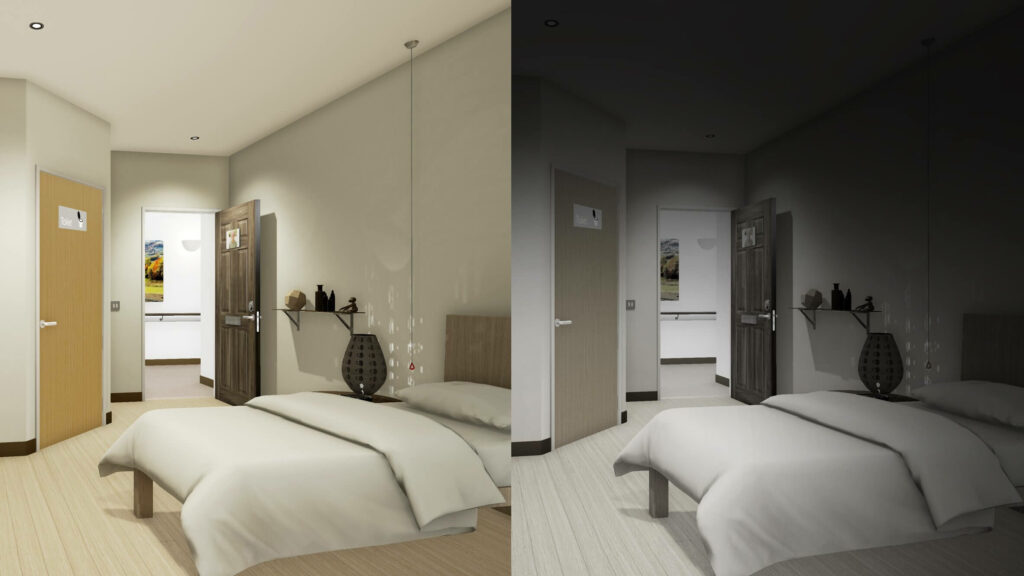
Visual showing appearance of a room with the Virtual Reality Empathy Platform headset and without it. Image credit: Dezeen
Method
Virtual Reality Empathy Platform Dementia is elaborated to simulate the environment seen by one with dementia. VR-EP system includes a laptop with high-performance graphic and memory capability, VR glasses, camera, a games controller and custom software programming.
Conclusion
Let’s summarize how virtual reality, empathy, and society are interrelated. Virtual reality is a product made by a human. Nevertheless, it affects a person too. There are different opinions to what extent virtual reality can produce empathic feelings. Nevertheless, most experts agree that IVE (immersive virtual environment) can cause empathy, like other traditional media. It is indisputable that when VR gets into the game, immersion makes us more emotional concerning what we experience.
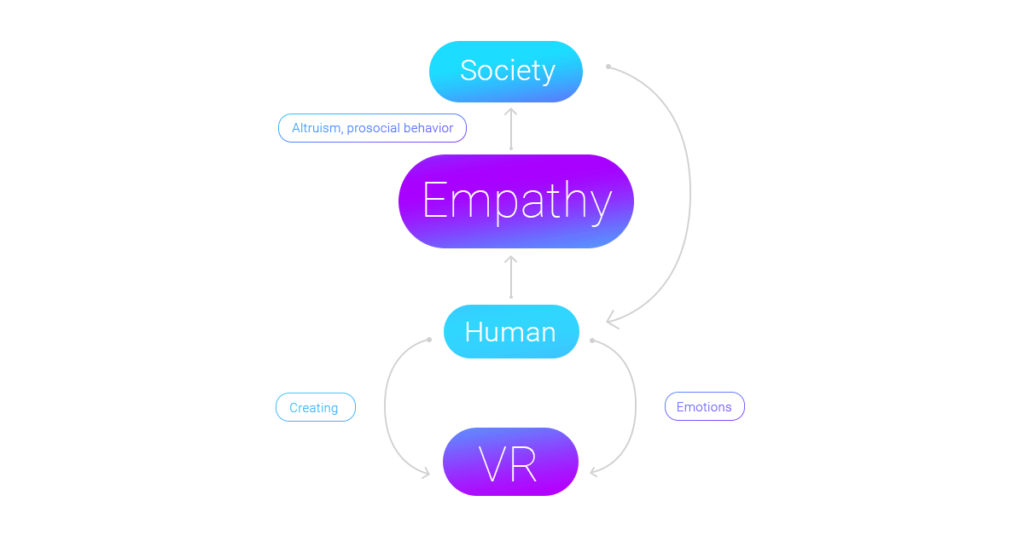
Empathy and virtual reality: how they change a human and society on the whole
Researches of our brain confirm that immersed in the virtual world, we begin to compare our personal experience with the one that another person has. Furthermore, brain zones responsible for emotional processing and empathy activate. One thing is undoubtedly clear. If empathy is an integral quality of one’s personality, immersive virtual experience intensifies it. Since empathy is connected not only with our perception of ourselves but also with other people, it works upon our social interactions. If one sympathizes with a person, then it is more likely that he or she will help the object of the feelings. In general, the more empathеtic a person is, the less the number of negative social events an individual has. Instead of being angry an empath feels pity and empathy. There are some psychological approaches and behavioral researches, including Stanford’s, confirming that empathy provokes altruism and prosocial behavior. Two forenamed activities vastly ensure the welfare of social groups at different levels. In its turn, acting altruistically, a person changes for the better, changing perception of self and receiving feedback about his or her actions from other people. Thus, VR gives additional value as a means of human and society formation.
